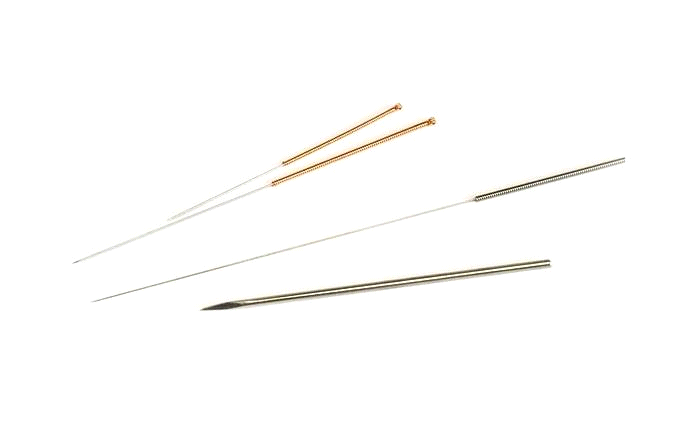Many people are familiar with the concept of acupuncture treatment, but few have heard of dry needling. When compared simply in pictures, it can be difficult to distinguish between the two. This is because both practices insert thin, stainless steel needles into the skin. Both treatments also claim to be able to treat pain.
This is where the similarities between the two practices end. One of the biggest differences between the two is that one method has been practiced for thousands of years, and has solid research backing its claims of effectiveness. Whereas, the other practice has been adopted in the last few decades.
Acupuncture is designed to relieve pain, discomfort, or other issues by opening up and stimulating a person’s energy flow, or qi. Dry needling is designed to stimulate trigger points or muscles that are irritated.
Trigger myofascial points, or palpable sources of pain, and their referral patterns have been described as myofascial meridians in acupuncture. These painful points are referred to as “A-shi” (like ouch, or painful) points in acupuncture.
In western medicine, in the 1940s, Janet Travell, M.D. first identified muscular trigger points and their referral patterns. Travell used injections of solutions, and dry needling (non-hollow needles that do not inject solution into trigger points). During the last three decades, others have empathized the use of dry needling not based on acupuncture concepts. In 1983, Travell and others found a very high correspondence (92%) between acupuncture points and the trigger points she had discovered.
Dry needling does not use the wide range of theories and applications of acupuncture to treat pain, and the non-musculoskeletal problems that cause pain. Many acupuncturists consider dry needling as a form of acupuncture performed by non-acupuncturists. A well-trained acupuncturist will make use of “trigger points” or A-shi points, and other sources of pain. Dr. Durana’s acupuncture treatment makes use of trigger points and myofascial pain patterns within the context of holistic traditional acupuncture, and acupuncture sports medicine. Dry needling, on the other hand, makes use of concepts based primarily on western medicine.
The position of the American Medical Association, or AMA, is that practitioners of dry needling focus more narrowly on musculoskeletal pain. It is also the recommendation of the AMA that practitioners of dry needling should be required to have at least minimum standards including formal training, testing, continuing education, and certification standards that are very much the same as those for acupuncture practitioners; however, those standards are not being presently met.
Here is a brief overview of other aspects of these practices to help you decide which treatment method is most beneficial to you.
Acupuncture
Acupuncture is an ancient medical practice, dating back thousands of years, originating in Asia. Licensed acupuncturists must complete three to four years of training. During their training, acupuncturists learn how to use the needles and diagnose conditions. Aside from their formal training, acupuncturists must pass a test administered by a board of examiners and take continuing education classes to keep their license.
Benefits of Acupuncture
One of the fundamental beliefs in acupuncture is that illness, pain, and other conditions are the result of blocked or interrupted qi. Qi is what provides your body with healing energy. Therefore, acupuncture strives to restore the flow of qi by removing the blockages. Acupuncture patients often report benefits in well-being; this may include an increase in energy, mental clarity, improvement in sleep, digestive health, and overall health. Some of the most common conditions that acupuncture is used to treat include pain, anxiety, respiratory problems, gastrointestinal disorders, neurological and musculoskeletal disorders, depression, insomnia, sports medicine, adverse reactions to chemotherapy and radiotherapy, infertility, sexual dysfunction, nausea, vomiting, headaches, and more.
Risks of Acupuncture
When acupuncture is administered by a trained and licensed acupuncturist, the side effects and associated risks are minimal. Occasionally, but rarely, an individual may experience:
- Pain at the injection site
- Bruising
- Bleeding
Dry Needling
Dry needling is a new treatment growing in popularity. Dry needling is intended to ease muscular pain by inserting fine, short, stainless steel needles into areas of knotted or hard muscles or tissues. Those who practice dry needling believe the insertion of the needle helps release the knot and relieve any muscle pain or spasms. Currently, dry needling is practiced by physical and sports injury therapists. There is no extensive training or regulatory agency for this procedure. Because there is no credentialing board, it is difficult to determine the legitimacy of a person’s training.
Benefits of Dry Needling
Dry needling can provide relief for some muscular pain and stiffness. When the trigger points are released, flexibility may improve, along with an increase in range of motion. Because of these benefits, dry needling is often used to treat sports injuries, muscle pain, and fibromyalgia pain. As research continues and becomes more available, guidelines for safe practices will likely be standardized.
Risks of Dry Needling
Unlike acupuncture, mild side-effects are extremely common with dry needling, with serious side effects being rare. The most common side-effects an individual will experience around the injection site include:
- Bruising
- Bleeding
- Temporary Soreness
Before you go in for any kind of treatment, ensure the practitioner always use sterile needles and disposes of needles after every use.

